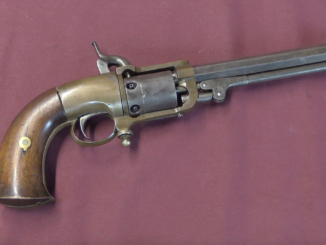This is lot #3221 in the upcoming RIA Premier Auction. It was scheduled for April, but has been postponed – check their web site for upcoming Online Only auctions every month, though!
Designed by Silvanus Frederick van Choate and manufactured by the Brown Manufacturing Company of Newburyport Massachusetts, this was a single shot rifle entered into US military testing in 1872. It has a number of interesting features – although that is not that same as having useful features. In particular, it has an unusual internal hammer firing system, which accounts for the dual triggers. The rear trigger is actually the cocking lever (opening the bolt will also recheck the hammer automatically) and the front trigger fires the rifle. This allows for manual decocting, albeit in a way that would be considered quite hazardous by today’s standards. Choate also patented a system for adjusting the friction of the bolt opening and closing, which appears to have been implemented in this rifle. This is a great example of an answer to a question nobody was asking…
Not surprisingly, the rifle failed to make an impression in testing, and only a handful were ever made. It did not see commercial sale.
https://patents.google.com/patent/US94047A
https://patents.google.com/patent/US89902A



Would friction adjustment have an impact on bold cycling speed?
If yes, it may have been imagined useful to control the rate of fire for massed volleys.
A spring-loaded extractor with a nub at the rear could have done double duty (depress the nub to remove the bolt without a screwdriver).
*or a loose part to go missing.
I’m not sure how to think about the comment that no one ever complains about the bolt being too hard or too easy. I have heard MANY people complain about cock-on-close being too hard, or Mosin bolts being either too hard or too easy, depending on wear and cleanliness.
That said…I agree that an adjustment to that particular thing is a bit much.
They’re wimps, not REAL MEN, like those of us who post to this Blog
Working the bolt of any rifle for military style timed or rapid fire, you really don’t notice if it’s “harder” to operate a cock-on-closing bolt action, such as the Swedish Mauser or any version of the Lee-Metford/Lee-Enfield family.
As for the Mosin-Nagant, like the M98 Mauser and Springfield it’s a cock-on-opening action. The fact that it takes more muscle to operate has less to do with exactly when the sear engages the firing pin and more to do with it being a different design than the Mauser type, with more bolt lift and less leverage.
cheers
eon
“(…)system for adjusting the friction of the bolt opening and closing(…)”
Do not ask: is this useful? Do: can this be patented?
The fixed extractor may have worked well in a magazine fed rifle, since the cartridge would feed upwards as it is fed into the chamber. One way to alleviate the problem of making sure the rim lipped into the extractor groove on a single shot rifle would be to have an angled feed ramp/tray, so when the bolt was fully open, the rear of cartridge would be angled downwards relative to the axis of bolt travel and the rim of the cartridge would sit below the extractor. Then as the bolt was closed and the cartridge fed into the chamber, the angle would force the rear of the cartridge upwards and the rim would lip into the extractor, sort of like the Mauser controlled feed.
Anyone not notice the potential to accidentally shoot a friend in the knee when trying to let the hammer down without intending to shoot? I wonder how many bullets to the knees would have happened if this system were adopted for service without modifications.
If however the firing pin is spring loaded of the intertia type then it is not only safe but very advanced. Remember Ian was not able to get the firing pin to protrude.